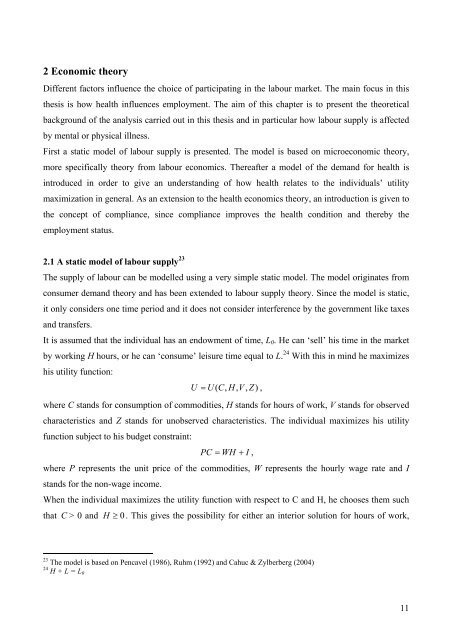An Analysis on Danish Micro Data - School of Economics and ...
An Analysis on Danish Micro Data - School of Economics and ...
An Analysis on Danish Micro Data - School of Economics and ...
You also want an ePaper? Increase the reach of your titles
YUMPU automatically turns print PDFs into web optimized ePapers that Google loves.
2 Ec<strong>on</strong>omic theory<br />
Different factors influence the choice <strong>of</strong> participating in the labour market. The main focus in this<br />
thesis is how health influences employment. The aim <strong>of</strong> this chapter is to present the theoretical<br />
background <strong>of</strong> the analysis carried out in this thesis <strong>and</strong> in particular how labour supply is affected<br />
by mental or physical illness.<br />
First a static model <strong>of</strong> labour supply is presented. The model is based <strong>on</strong> microec<strong>on</strong>omic theory,<br />
more specifically theory from labour ec<strong>on</strong>omics. Thereafter a model <strong>of</strong> the dem<strong>and</strong> for health is<br />
introduced in order to give an underst<strong>and</strong>ing <strong>of</strong> how health relates to the individuals’ utility<br />
maximizati<strong>on</strong> in general. As an extensi<strong>on</strong> to the health ec<strong>on</strong>omics theory, an introducti<strong>on</strong> is given to<br />
the c<strong>on</strong>cept <strong>of</strong> compliance, since compliance improves the health c<strong>on</strong>diti<strong>on</strong> <strong>and</strong> thereby the<br />
employment status.<br />
2.1 A static model <strong>of</strong> labour supply 23<br />
The supply <strong>of</strong> labour can be modelled using a very simple static model. The model originates from<br />
c<strong>on</strong>sumer dem<strong>and</strong> theory <strong>and</strong> has been extended to labour supply theory. Since the model is static,<br />
it <strong>on</strong>ly c<strong>on</strong>siders <strong>on</strong>e time period <strong>and</strong> it does not c<strong>on</strong>sider interference by the government like taxes<br />
<strong>and</strong> transfers.<br />
It is assumed that the individual has an endowment <strong>of</strong> time, L0. He can ‘sell’ his time in the market<br />
by working H hours, or he can ‘c<strong>on</strong>sume’ leisure time equal to L. 24 With this in mind he maximizes<br />
his utility functi<strong>on</strong>:<br />
U = U ( C,<br />
H,<br />
V , Z)<br />
,<br />
where C st<strong>and</strong>s for c<strong>on</strong>sumpti<strong>on</strong> <strong>of</strong> commodities, H st<strong>and</strong>s for hours <strong>of</strong> work, V st<strong>and</strong>s for observed<br />
characteristics <strong>and</strong> Z st<strong>and</strong>s for unobserved characteristics. The individual maximizes his utility<br />
functi<strong>on</strong> subject to his budget c<strong>on</strong>straint:<br />
PC = WH + I ,<br />
where P represents the unit price <strong>of</strong> the commodities, W represents the hourly wage rate <strong>and</strong> I<br />
st<strong>and</strong>s for the n<strong>on</strong>-wage income.<br />
When the individual maximizes the utility functi<strong>on</strong> with respect to C <strong>and</strong> H, he chooses them such<br />
that C > 0 <strong>and</strong> H ≥ 0.<br />
This gives the possibility for either an interior soluti<strong>on</strong> for hours <strong>of</strong> work,<br />
23 The model is based <strong>on</strong> Pencavel (1986), Ruhm (1992) <strong>and</strong> Cahuc & Zylberberg (2004)<br />
24 H + L = L0<br />
11
















